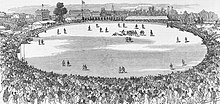Australian rules football in Australia
In most states it is referred to simply as football or footy however in New South Wales and Queensland it is promoted under the acronym AFL by the local development bodies.
It is also fast growing in New South Wales and in Queensland, though with participation rates there of 1.2% it is considered a minor sport, lagging behind soccer and rugby league in overall interest.
These two states represent more than half of the Australian population and this dichotomy of football culture is referred to as the Barassi Line.
From 2007 to 2019 the underage men's team competed annually against international opponents as the AFL Academy most recently against New Zealand.
Australia has also fielded amateur teams against South Africa, Papua New Guinea and the United States.
Delegates representing the football associations of South Australia, Tasmania, Victoria and Queensland met in 1883 in order to standardise the rules across the colonies.
The sport has had a significant impact on popular culture in its native Australia, capturing the imagination of Australian film, art, music, television and literature.
[5] In 2005, a cumulative 6,283,788 people attended Australian Football League (AFL) premiership matches, a record for the competition.
According to OzTAM, in recent years, the AFL Grand Final has reached the top five programs across the five biggest cities in 2002, 2003, 2004, 2005 and 2006.
The competition is monitored by AFL recruiters and frequently seen as the second biggest pathway for junior players to the fully professional Australian Football League.
The competition receives an increasing amount of coverage in the media, however still lags behind the TAC Cup in terms of interest in Victoria.


